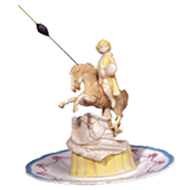Where Has all The Good Time Gone?
Matt Rowe presents us with the faded spectacle and isolated amusements. He has manipulated the photo with washes of colour or digital additions. We see the highlighted edges of a ride, the lights of an amusement arcade, tempting us with echoes of a past glamour, with packed crowds and good times. The conscious choice of a memoir aesthetic suggests the images are from the past. With an aura of nostalgia the photographs not only present a longing for a prior era but further anticipate the changes yet to occur on the Rotunda site.
The temporary amusements are already in the past, already part of the shifting landscape of Folkestone’s redevelopment campaign. For Matt Rowe, the shift in the seaside resort is a moment to be recorded marking a point of transition from the dreamland’s of the past to the seasides of the present. It is a shift that leaves us with a space of uncertainty, a disenchanted, sad and occasionally ferocious amusement park, a sight to be captured and commemorated along with other seaside eras.









“In the broadest sense, O Dreamland is a film of protest…the camera-eye turns on society – ‘society’ is really too big and anonymous a word, it is better to say ‘life now’ – is disenchanted, sad, occasionally ferocious and bitter.”
Gavin Lambert Free Cinema Sight and Sound Spring 1956
The 1953 film O DreamLand directed and produced by Lindsay Anderson, takes a look at the visitors to Margate’s Dreamland fun fair. For ten minutes it is a sharp centred survey of the theme park. The camera’s distanced gaze takes in the visitors and the fair- ground frivolities, revealing both to be a disenchanted spectacle.Matt Rowe has taken O Dreamland’s premise of recording the funfair scene and taken a series of photographs of the contemporary Rotunda amusement park in Folkestone, Kent. He has documented the Rotunda site with the use of a vintage camera, commenting on the decline of the seaside resort. The previ- ously iconic Rotunda is undergoing a period of transition. The roller coaster, an emblem of the town’s Dreamland hay day, was recently demolished due to redevelopment plans. In the lull between demolition and development the site was occupied by a temporary fun fair. The seaside spectacle of amusements and roller coasters is gradually changing.
Sites such as the rotunda signify key parts of the town’s identity, history and social network. The hub of social activity and survey of society seen in O Dreamland has turned into a somewhat empty amusement park with isolated individuals. The Rotunda fairground was a local hang out in the school holidays, the souvenir shops a site to roam through on lazy afternoons. The sea front cafes and ice cream vans all held a status within the community. They were places to meet, to work, to hang out, and eat candy floss. With the removal of the Rotunda, and its shift into a temporary site ,the social space of the fair has, in turn, shifted. It is a little empty with fewer rides and familiarity, a sad reminder of former activity. Where O Dreamland documented the mass enjoyment of the seaside spectacle, albeit a little grotesque in the surreal revelation of amusement culture, Matt Rowe’s photographs depict the present era where it is no longer the bombardment of rides and entertainers that disturbs the senses but of the present, a social realism no longer gilded but stripped bare, awkward and isolated Matt Rowe has chosen to use a vintage camera to document the Rotunda scene. The use of the camera creates an equally vintage aesthetic, the faded tones nodding to the contemporary sparsity and igniting a nostalgia for the loss of brighter eras, of a seaside committed to memory. Struck through with candy coloured pigments the images are brought back into a more recent history. Rather the lack of individuals, of crowds, and glamour. It is a bare and sparse amusement park. We are shown a figure passing through, or waiting at the edge of a ride. A mobility scooter, a pram, and a hooded sweatshirt replace the dresses and candy floss of the ideal seaside resort. If the 1950s Dreamland was an ‘alternatively camp and luxuriously sad, a kind of gilded social realism
Matt Rowe presents us with the faded spectacle and isolated amusements. He has manipulated the photo with washes of colour or digital additions. We see the highlighted edges of a ride, the lights of an amusement arcade, tempting us with echoes of a past glamour, with packed crowds and good times. The conscious choice of a memoir aesthetic suggests the images are from the past. With an aura of nostalgia the photographs not only present a longing for a prior era but further anticipate the changes yet to occur on the Rotunda site. The temporary amusements are already in the past, already part of the shifting landscape of Folkestone’s redevelopment campaign. For Matt Rowe, the shift in the seaside resort is a moment to be recorded marking a point of transition from the dreamland’s of the past to the seasides of the present. It is a shift that leaves us with a space of uncertainty, a disenchanted, sad and occasionally ferocious amusement park, a sight to be captured and commemorated along with other seaside eras.
Text By Laura Mansfield
